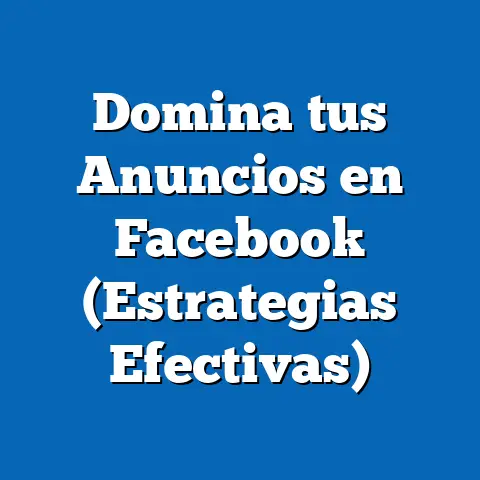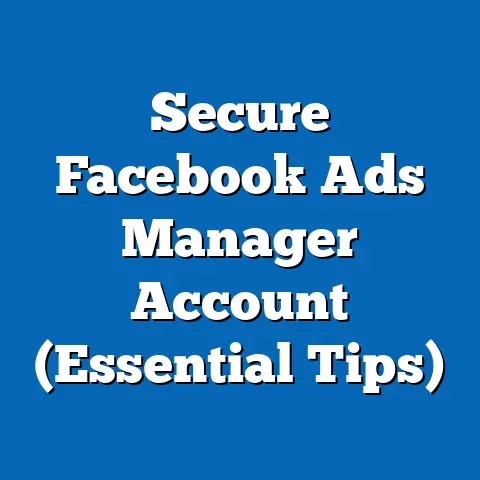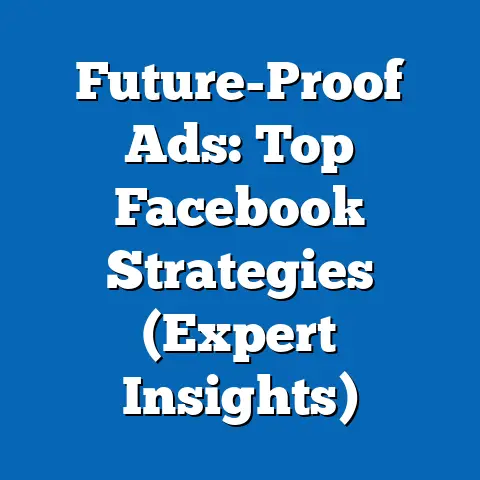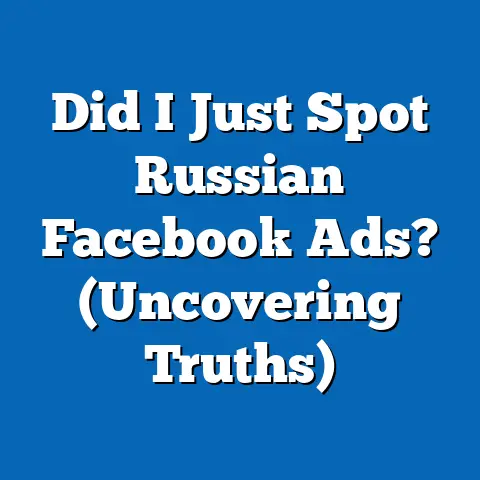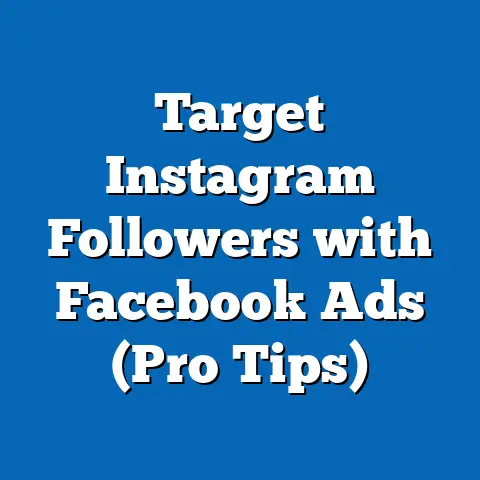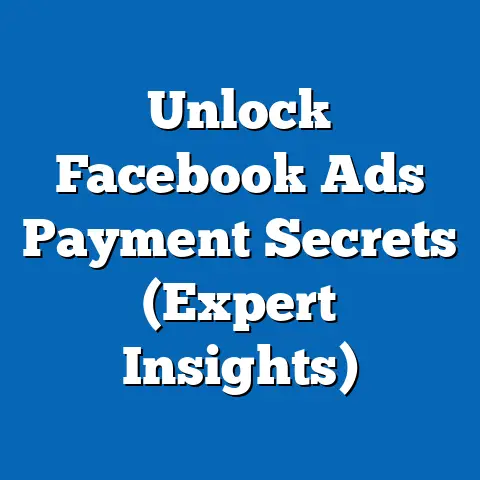Supercharge Lead Generation with Facebook Ads (Expert Tips)
What if a single platform could transform your business by connecting you with millions of potential customers, precisely targeted to your niche, at a fraction of the cost of traditional marketing? Enter Facebook Ads—a digital advertising juggernaut that has redefined how businesses generate leads in the 21st century. With over 2.9 billion monthly active users as of 2023, according to Statista, Facebook offers an unparalleled opportunity to reach diverse demographics across generations, geographies, and interests.
Lead generation, the process of attracting and converting prospects into potential customers, is the lifeblood of any business. Facebook Ads, with its sophisticated targeting tools, cost-effective scalability, and dynamic ad formats, has become a cornerstone for marketers aiming to supercharge their efforts. But what makes this platform so effective, and how can businesses—small or large—leverage it to its fullest potential?
Section 1: The Historical Context of Facebook Ads and Digital Lead Generation
Facebook launched its advertising platform in 2007, initially as a rudimentary tool called “Flyers,” allowing businesses to promote events and services to college students. This early iteration was a far cry from the robust ecosystem we see today, but it laid the groundwork for what would become a game-changer in digital marketing. By 2012, with the introduction of Custom Audiences and retargeting capabilities, Facebook Ads evolved into a precision tool for lead generation, capitalizing on the platform’s growing user base and data collection prowess.
The rise of Facebook Ads coincided with a broader societal shift toward digitalization. The early 2000s saw the internet become a household staple, with social media platforms emerging as central hubs for communication and commerce. Businesses, previously reliant on print ads, cold calling, and direct mail for leads, began pivoting to online channels where consumer behavior could be tracked and analyzed in real time.
This historical pivot wasn’t just technological—it was cultural. Millennials, often dubbed the first “digital natives” (born roughly between 1981 and 1996), were coming of age during this period, shaping online trends and demanding personalized, interactive marketing. Meanwhile, older generations like Gen X (born 1965-1980) and Baby Boomers (born 1946-1964) adapted to digital tools, broadening the audience pool for platforms like Facebook. The societal implication was clear: businesses had to meet consumers where they were—online—or risk obsolescence.
Today, Facebook Ads isn’t just a tool; it’s a reflection of how data-driven marketing has reshaped economies. Small businesses, once constrained by budget, can now compete with industry giants through targeted campaigns. However, this democratization comes with challenges, including privacy debates and evolving regulations like GDPR (General Data Protection Regulation), which we’ll explore later.
Section 2: Defining Characteristics of Facebook Ads for Lead Generation
What sets Facebook Ads apart as a lead generation powerhouse? At its core, the platform combines unparalleled reach with granular targeting options, making it a versatile tool for businesses across industries. Let’s break down its defining characteristics.
First, audience targeting precision is a standout feature. Using data from user profiles, behaviors, and interests, advertisers can target specific demographics—say, Gen Z gamers in urban areas or Baby Boomer retirees interested in travel. Tools like Lookalike Audiences allow businesses to find users similar to their existing customers, amplifying conversion potential.
Second, cost-effectiveness and scalability make Facebook Ads accessible. Unlike traditional media, where costs skyrocket with reach, Facebook operates on a pay-per-click (PPC) or pay-per-impression model, with average costs per lead ranging from $0.97 to $2.50, depending on the industry, as per WordStream’s 2023 data. Small businesses can start with minimal budgets and scale as they see results.
Third, dynamic ad formats cater to diverse consumer preferences. From carousel ads showcasing multiple products to lead form ads that capture information directly within the platform, businesses can tailor content to generational habits—short, engaging videos for Gen Z, or detailed posts for Gen X decision-makers.
Finally, real-time analytics empower advertisers to optimize campaigns on the fly. Metrics like click-through rates (CTR), cost per lead (CPL), and conversion rates provide actionable insights, a stark contrast to the guesswork of traditional advertising. This data-driven approach aligns with modern expectations for efficiency and accountability.
Section 3: Societal Implications of Facebook Ads in Lead Generation
The widespread adoption of Facebook Ads has far-reaching implications for society, culture, and the economy. On one hand, it has democratized marketing, enabling entrepreneurs from diverse backgrounds to reach global audiences without the gatekeeping of traditional media. A 2022 study by Hootsuite found that 58% of small businesses rely on social media advertising as their primary lead generation tool, with Facebook leading the pack.
However, this shift also raises ethical concerns. The platform’s reliance on user data for targeting has sparked debates over privacy, especially among younger generations like Gen Z, who value transparency and data control. High-profile scandals, such as the 2018 Cambridge Analytica incident, where user data was misused for political ads, have fueled mistrust. Societally, this has led to calls for stricter regulations, influencing how businesses approach lead generation with transparency in mind.
Economically, Facebook Ads has contributed to the gig economy and remote work trends. Freelancers and digital marketers, often from Gen Y and Gen Z, have built careers around managing ad campaigns, reflecting a generational shift toward flexible, tech-driven professions. Yet, this also exacerbates digital divides—businesses without digital literacy, often run by older generations, may struggle to keep up.
Culturally, the platform has redefined how trust is built between brands and consumers. Personalized ads can feel invasive if not executed thoughtfully, particularly to privacy-conscious demographics. Conversely, well-crafted campaigns resonate deeply, as seen with viral ads targeting Millennials’ nostalgia or Gen Z’s humor. The implication? Businesses must balance data use with authenticity to maintain credibility across generations.
Section 4: Expert Tips to Supercharge Lead Generation with Facebook Ads
Now that we’ve contextualized Facebook Ads, let’s dive into actionable strategies to maximize lead generation. These expert tips are informed by industry best practices, case studies, and data from sources like HubSpot, WordStream, and Social Media Examiner.
4.1: Define Your Audience with Precision
Before launching a campaign, invest time in understanding your target audience. Use Facebook’s Audience Insights to analyze demographics, interests, and behaviors—consider generational nuances, such as Gen X’s preference for value-driven offers versus Gen Z’s focus on social impact. Create buyer personas to guide your targeting, ensuring ads resonate with specific pain points and desires.
For instance, a fitness brand targeting Millennials might focus on work-life balance, while ads for Baby Boomers could emphasize health longevity. Testing multiple audience segments with A/B testing can refine your approach, as evidenced by a 2021 case study from Shopify, where segmented targeting increased lead conversion by 34%.
4.2: Leverage Lead Form Ads for Seamless Conversion
Facebook’s Lead Form Ads allow users to submit contact information without leaving the platform, reducing friction in the conversion process. Customize forms to collect only essential data—name, email, and a key qualifier like budget range—to boost completion rates. According to Facebook’s own data, lead forms can lower cost per lead by up to 20% compared to driving traffic to external landing pages.
Tailor form questions to generational expectations. Younger users may prefer quick, minimal forms, while older demographics might appreciate detailed options to build trust. Always include a clear call-to-action (CTA) like “Get Your Free Quote” to drive urgency.
4.3: Craft Compelling Creative Content
Visuals and copy are the heart of any ad. Use high-quality images or videos that align with your audience’s aesthetic—think vibrant, trend-driven visuals for Gen Z or professional, polished content for Gen X executives. Video ads, in particular, have a 27.4% higher CTR than static images, per a 2023 Social Media Examiner report.
Your copy should address pain points and offer solutions. For example, a real estate company targeting Millennials might highlight affordable starter homes with a headline like “Own Your Dream Home Before 30!” Test multiple ad variations to identify what resonates most, using Facebook’s split testing tools.
4.4: Optimize for Mobile-First Experiences
With 98.5% of Facebook users accessing the platform via mobile devices (Statista, 2023), mobile optimization is non-negotiable. Ensure ad visuals are clear on smaller screens, load times are fast, and CTAs are thumb-friendly. Lead forms should be concise to prevent user drop-off on mobile.
Generational habits play a role here—Gen Z and Millennials are predominantly mobile users, often engaging with ads on the go, while older generations may split time between mobile and desktop. Design with mobile-first in mind but test cross-platform performance to cover all bases.
4.5: Use Retargeting to Re-Engage Warm Leads
Not every user converts on the first interaction. Retargeting, enabled by the Facebook Pixel (a tracking code installed on your website), allows you to re-engage users who’ve shown interest—visited your site, added to cart, or engaged with past ads. A 2022 HubSpot study found retargeting ads can increase conversion rates by up to 150%.
Craft retargeting campaigns with personalized messaging. For instance, offer a discount to users who abandoned a purchase, or remind them of a webinar they signed up for. Be mindful of ad fatigue, especially with younger audiences who value variety—limit frequency and rotate creative content.
4.6: Monitor and Optimize with Analytics
Facebook’s Ads Manager provides a wealth of data to fine-tune campaigns. Track metrics like CPL, CTR, and conversion rate to gauge performance. If a campaign targeting Gen Z underperforms, analyze whether the issue lies in creative content, targeting, or budget allocation, then adjust accordingly.
Set clear KPIs (key performance indicators) before launching—say, generating 100 leads at $2 each within a month. Use A/B testing to compare ad elements, and don’t shy away from pausing underperforming campaigns to reallocate budget. Continuous optimization is key to sustained success.
4.7: Navigate Privacy Regulations and Build Trust
With increasing scrutiny on data usage, compliance with privacy laws like GDPR and CCPA (California Consumer Privacy Act) is critical. Be transparent about data collection in your ads and forms, offering opt-out options where required. A 2023 survey by Pew Research found that 74% of users, especially Gen Z, are more likely to engage with brands that prioritize privacy.
Post-iOS 14.5 updates (Apple’s App Tracking Transparency), tracking has become trickier with reduced data access. Counter this by focusing on first-party data—collecting info directly via lead forms or website interactions—and diversifying lead sources beyond Facebook.
Section 5: Generational Nuances in Facebook Ads Lead Generation
Generational differences significantly influence ad effectiveness, as each cohort has unique values, tech savviness, and purchasing behaviors. Understanding these nuances prevents a one-size-fits-all approach and boosts campaign relevance.
-
Baby Boomers (1946-1964): Often overlooked, Boomers are active on Facebook, with 68% using the platform regularly (Pew Research, 2022). They value trust and detailed information, responding well to ads for health, retirement, or family-oriented products. Use clear, benefit-driven messaging and avoid overly trendy language.
-
Gen X (1965-1980): As pragmatic decision-makers, Gen X appreciates value and efficiency. They’re likely to engage with ads for career development, home improvement, or financial services. Focus on problem-solving content and professional visuals, balancing mobile and desktop optimization.
-
Millennials (1981-1996): This tech-savvy group prioritizes authenticity and social responsibility. They respond to personalized, story-driven ads for experiences, sustainable products, or tech gadgets. Incorporate user-generated content or influencer partnerships to build credibility.
-
Gen Z (1997-2012): Known for short attention spans and social consciousness, Gen Z demands quick, visually striking ads. They’re drawn to brands with purpose—think eco-friendly or inclusive messaging. Use video formats like Stories or Reels, and engage on trending topics to capture their interest.
Diversity within generations exists—cultural background, income level, and location shape responses as much as age. Tailor campaigns with data insights rather than assumptions, ensuring inclusivity in messaging and imagery.
Section 6: Challenges and Future Trends in Facebook Ads Lead Generation
Despite its strengths, Facebook Ads faces challenges that could impact lead generation strategies. Privacy regulations and platform updates, like Apple’s tracking restrictions, have reduced targeting accuracy, pushing advertisers to adapt. A 2023 report by eMarketer predicts a 15% drop in ad effectiveness for iOS users due to these changes, urging businesses to explore alternative platforms like TikTok or LinkedIn for diversified reach.
Ad fatigue is another hurdle. With users seeing hundreds of ads daily, standing out requires constant innovation in creative content and messaging. This is especially true for younger demographics who quickly tune out repetitive campaigns.
Looking ahead, trends like AI-driven ad optimization and augmented reality (AR) ads offer exciting possibilities. AI tools can predict user behavior with greater accuracy, while AR lets users interact with products virtually—think trying on glasses or visualizing furniture in their home. These innovations could redefine engagement, particularly for tech-forward Gen Z and Millennials.
Economic factors, such as inflation or recession fears, may also influence ad spend. Businesses might tighten budgets, focusing on high-ROI campaigns, while consumers could become more selective, prioritizing essential purchases over impulse buys. Adaptability will be crucial in navigating these uncertainties.
Section 7: Implications for Businesses and Society
For businesses, mastering Facebook Ads translates to competitive advantage. Effective lead generation drives revenue, builds customer bases, and fosters brand loyalty across generations. Small businesses, in particular, benefit from leveling the playing field, accessing tools once reserved for corporate budgets.
In the workplace, reliance on digital ads has spurred demand for skilled marketers and data analysts, reshaping job markets. Younger generations entering the workforce often bring native digital skills, while older workers may require upskilling to stay relevant—a dynamic that underscores the need for inclusive training programs.
Societally, the dominance of platforms like Facebook raises questions about data ethics and consumer autonomy. As lead generation becomes more sophisticated, balancing personalization with privacy will be paramount. Governments and platforms may face pressure to enforce stricter guidelines, impacting how businesses operate.
Culturally, the shift to digital-first marketing reflects broader generational trends—immediacy, connectivity, and individualism. Yet, it risks widening gaps for those less tech-savvy, highlighting the need for digital equity initiatives to ensure no demographic is left behind.
Conclusion: Forward-Looking Insights for Sustainable Success
Facebook Ads remains a titan in lead generation, offering tools and reach unmatched by most platforms. By leveraging precision targeting, dynamic formats, and data analytics, businesses can supercharge their efforts, connecting with diverse generations in meaningful ways. The expert tips outlined—audience definition, mobile optimization, retargeting, and beyond—provide a roadmap for success, grounded in real-world data and trends.
Yet, the landscape is ever-evolving. Privacy concerns, technological disruptions, and economic shifts introduce uncertainties that demand agility. Businesses must stay ahead by embracing innovation, like AI and AR, while prioritizing ethical data use to maintain consumer trust.
Looking forward, the interplay between generational preferences and digital marketing will continue to shape lead generation. Will Facebook adapt to retain its dominance, or will emerging platforms steal the spotlight? Only time will tell, but one thing is certain: mastering tools like Facebook Ads today positions businesses to thrive in tomorrow’s unpredictable digital frontier.

